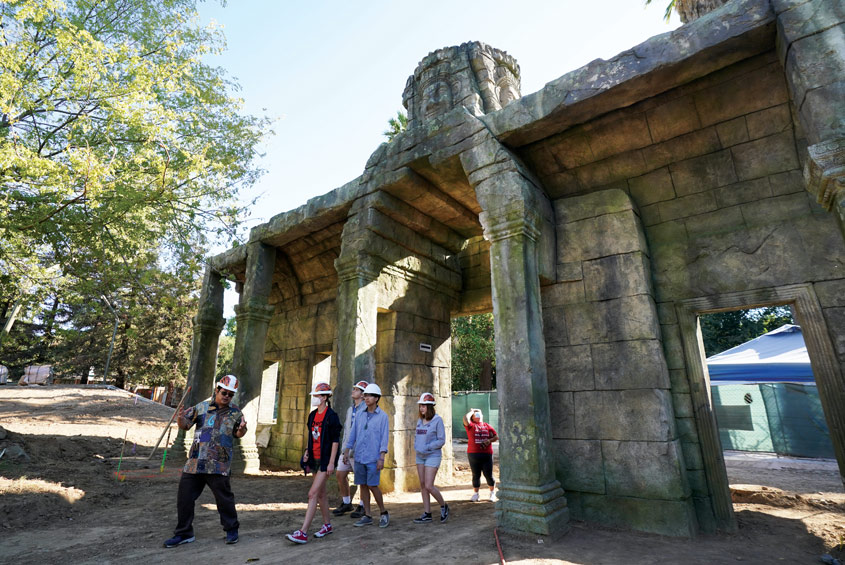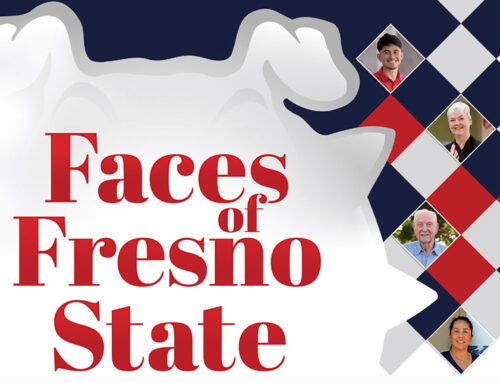Eyeing a New Partnership
See how Fresno State faculty and students partnered with the Fresno Chaffee Zoo on the new Kingdoms of Asia exhibition
By Eddie Hughes (’05)
Photos by Cary Edmondson (’03)
Gazing up at the intricate rockwork beneath the remnants of an ancient Cambodian temple, a group of students follows its professor through the entryway as if it’s a portal into another time and place. The dense jungle landscape has reclaimed the temple, with trees sprouting high atop the structure and roots as thick as boa constrictors seemingly squeezing the stone façade into submission. As birds chirp and siamang apes sing nearby, the group scans the horizon, wary of predators. Just a few feet away is a gently flowing stream, known as a popular watering hole for Malayan tigers, and home to the Sunda gharial, a large crocodilian species. What an adventure this is going to be.
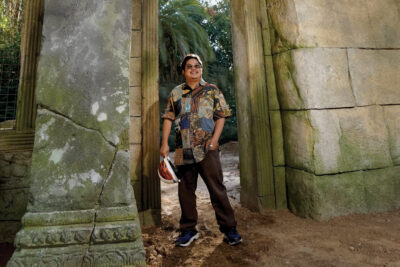 This Southeast Asian jungle habitat is only miles away from the Fresno State campus. It’s part of the new Kingdoms of Asia exhibition at the Fresno Chaffee Zoo.
This Southeast Asian jungle habitat is only miles away from the Fresno State campus. It’s part of the new Kingdoms of Asia exhibition at the Fresno Chaffee Zoo.
“It’s beyond words, it’s so impressive,” says Dr. W. Saam Noonsuk (left), an art history professor at Fresno State who served as a cultural adviser for the new exhibition and now looks forward to sharing the experience with his students. “It looks real. It’s quite authentic. This project will be transformative for my students because they don’t have these types of temples around Fresno.”
Similar in scope to the zoo’s popular African Adventure exhibition that opened in 2015, Kingdoms of Asia is scheduled to open to the public in February 2023. In addition to tigers, orangutans and Sunda gharial, it will include sloth bears, Asian small-clawed otters and a new habitat for the Komodo dragon.
The impressive surroundings, inspired by Southeast Asian temples such as Bayon and Ta Prohm from 12th and 13th century Cambodia, are all part of the experience envisioned by Fresno Chaffee Zoo leadership. The detailed rockwork is similar to the scenic design one might expect of a Disneyland attraction, transitioning visitors into another era.
“It looks beautiful,” Noonsuk says. “There are big trees, there are roots intertwined into the ruins, and it looks like the place was reclaimed by nature.”
To make sure the Kingdoms of Asia exhibition was authentic and respectful to the cultures represented, advisory groups were formed with subject-matter experts like Noonsuk who used their expertise and met with members of the Southeast Asian community to bring the project to life in an honorable way.
Noonsuk, who is originally from Thailand, earned his Ph.D. in history of art, archaeology and visual studies from Cornell University.
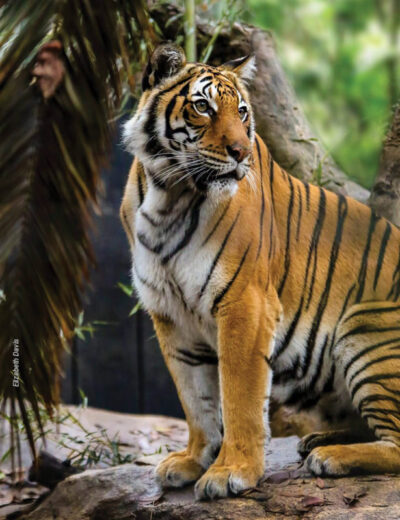 Inspired by the Bayon Temple in Cambodia, Noonsuk advised the group on the significance of four faces atop the structure serving as the entrance to the exhibition. The faces represent a deity looking over the people to the north, east, south and west.
Inspired by the Bayon Temple in Cambodia, Noonsuk advised the group on the significance of four faces atop the structure serving as the entrance to the exhibition. The faces represent a deity looking over the people to the north, east, south and west.
Noonsuk helped influence intricate details of the design, from the circular shape of the temple’s pillars, to the rockwork depicting songbirds and serpents that were often considered sacred in Southeast Asian cultures.
Coincidentally, when Noonsuk arrived at Fresno State in 2018, he was asked to teach a class titled, “Kingdoms of Monsoon Asia.” A year later, he was contacted by the Fresno Chaffee Zoo’s former chief mission officer, Dean Watanabe, to consult on the Kingdoms of Asia exhibition.
“My Southeast Asian background, knowledge and training helped them to have more accurate and appropriate expression within the exhibition,” Noonsuk says. “They asked me to feel free to share with them because they wanted to get it done right. They want to be culturally sensitive to the people.”
California is home to about 1 million Southeast Asian American residents, more than any other state in the U.S. One of the unique aspects of the exhibition is that it’s intended to educate and inform zoo visitors about the cultures of Southeast Asia, many of which have large representation in Fresno County.
“This exhibition is a really good example of what we are trying to do more and more, which is deepen our engagement, not only from the inspired experience about animals, but to tell people stories about the population here in the Central Valley,” says Fresno Chaffee Zoo CEO Jon Forrest Dohlin. “This is a great opportunity to tell a story about a place where humans and wildlife have lived in overlapping mosaics for millenia, but also about the Central Valley.”
Dohlin, an alumnus of California State University, Humboldt, became CEO at the zoo in February 2021 after previously serving as the director of the Wildlife Conservation Society’s New York Aquarium. He is uniquely positioned to lead the zoo’s multi-phased master plan with his background in architecture – he holds a master’s degree from Parsons School of Design in New York.
Kingdoms of Asia is an example of the exponential growth at Fresno Chaffee Zoo that is rare at other zoos nationally. And Dohlin is excited to soon announce additional projects as part of the master plan, including a reimagined and more modern entrance, parking garages, a California exhibition connecting the beaches to the redwoods and — to take things beyond the water’s edge — an aquarium.
A major emphasis for all of these projects will be giving animals the space they need to thrive. Decades ago, what was once an acceptable amount of space for various animal habitats is no longer considered a best practice, he says. And Dohlin wants the community to be part of that conversation about conservation and wildlife research — with messaging and other education components becoming commonplace at the zoo.
“We’re helping to create the next generation of environmental stewards, of conservation heroes,” Dohlin says. “Whether they’re a biologist or not, they could be a baker or a ballet dancer, but they’re going to care about wildlife and its ability to thrive in our world and that’s what will make the difference in conservation. People and wildlife thrive together.”
The Fresno Chaffee Zoo’s growth, Dohlin says, is a direct result of the support of the local community. The voters of Fresno County voted overwhelmingly in support of Measure Z three times — in 2004, 2013 and 2022 — for a one-tenth of 1% sales tax. The result? Fresno now has a zoo that rivals some of the best in the West, if not the nation. It has been completely transformed into one of the major destinations in Fresno, drawing people from all over the region and boosting the local economy.
It’s a prime example of how community support can spark transformational growth that benefits the entire region for generations.
Building Connections
In February, Fresno State and the Fresno Chaffee Zoo signed a memorandum of understanding to formalize a partnership that has existed in various areas for years.
In addition to Noonsuk’s and other professors’ work as advisers or consultants on zoo projects, there are also students from the College of Science and Mathematics who frequently test the zoo’s water filtration systems and analyze samples in the lab; there are students from the Jordan College of Agricultural Sciences and Technology who help plant the zoo’s gardens and farm areas; there are psychology faculty and students helping to make the zoo more inclusive for visitors with special needs and much more.
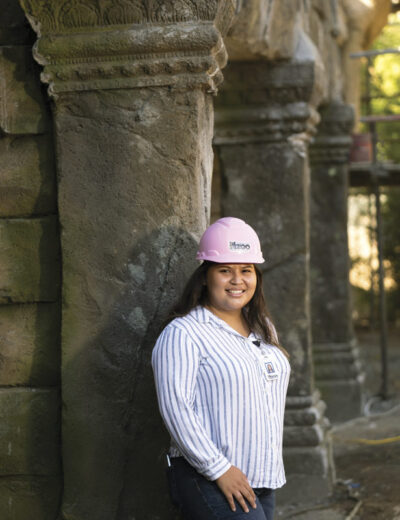 Pattrisia Casas is a senior construction management student in the Lyles College of Engineering at Fresno State. This past summer, she saw an announcement on campus that the zoo was looking for a project management intern. She applied, was called in for the interview and started on the job in July.
Pattrisia Casas is a senior construction management student in the Lyles College of Engineering at Fresno State. This past summer, she saw an announcement on campus that the zoo was looking for a project management intern. She applied, was called in for the interview and started on the job in July.
Casas works three days a week at the zoo and has fallen in love with its mission and her team. “It’s one of those jobs you dream of waking up to,” Casas says. “It doesn’t really feel like a job.”
While she notes how unique it is that “the lion is right there next to my car when I drive in,” her real inspiration is someone much farther away — her father.
Casas’ father worked in construction throughout her childhood, and some of her fondest childhood memories are helping him out with projects at work. But when she was in high school in Wasco, just north of Bakersfield, her father was deported to Mexico.
It left a void in Casas’ life until she figured out a way to feel linked to him again.
“I just felt out of touch, not connected, so I took a construction class at a vocational school,” Casas says. “It was really hands on, and I loved it — I fell in love with it.”
Her dad is still doing construction in Mexico, building mobile homes, and she visits him whenever she gets the opportunity.
In May, Casas will become the first member of her family to earn a college degree. She is the oldest sibling, with three younger brothers.
“My mom got pregnant when she was young,” Casas says. “All she’s ever wanted from me was to do better and that came with a lot of pressure. She’s overjoyed that I’m going to graduate.”
She expects her mother, stepfather and brothers will all be watching — and she says maybe her youngest brother will even follow in her footsteps and go to college himself.
“I’m pretty sure they’re going to cry, just as I am,” Casas says. “You plan something and it’s just amazing when you achieve it, which is why I love construction so much. You see the process and completion and it’s just amazing to say, ‘I did that.’”
After college, her goal is to become a project manager. “So far, I haven’t met a project manager who is a woman,” Casas says. “Leading the way for other women to do that is something I really want to do. I want to teach and inspire women to join the construction industry.”
Casas says as a freshman at Fresno State, there were just two other female students in her classes, but as a senior now she is seeing many more.
At the zoo, Casas is inspired by project coordinator Jodi-Ann Farias, a Fresno State alumna, and project manager Jesse Santiago. She says they each have trusted her with responsibility and continuously give her feedback as she works on the new Kingdoms of Asia exhibition as well as other projects.
Though her internship started as simply a requirement for graduation, it has opened her eyes to a potential career path.
“I really want to stay at the zoo, because I’ve learned so much and the people are amazing,” Casas says. “They work as a team, and I always feel included.”
A Welcoming Environment
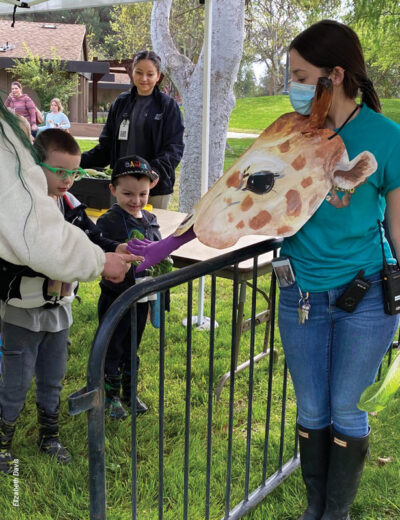
Children visiting the Fresno Chaffee Zoo practice for the interactive giraffe feeding in a way that allows them to gain comfort with the process and learn what to expect.
Creating an inclusive experience is important to the Fresno Chaffee Zoo. Fresno State psychology professor Marianne Jackson and her graduate students have been working with the zoo for the past four years to provide staff training about autism and individuals who might have difficulty with some aspects of the zoo such as waiting in lines and experiencing crowds and noise.
“If you’re a parent of a child with autism, you pay to get in, and you want to get your money’s worth,” says Jackson, the coordinator of Fresno State’s Applied Behavior Analysis master’s program.
The group partnered with Pal Experiences and Valley Children’s Healthcare to provide resources such as headphone zones and sensory backpacks. When individuals with autism arrived at the zoo, they could access more simplified maps and check out backpacks that include headphones for when noise is overstimulating, fidget toys and more. They also worked with the zoo to incorporate signage for entering headphone zones and identifying quiet places.

Children and families get a closer look at insects and bugs through microscopes.
Though the pandemic presented challenges for sourcing materials, Jackson hopes these changes continue into the future.
The Fresno Chaffee Zoo also hosted a special event for families with autism to experience the zoo together in personalized ways. The event sold out immediately with an allotment of about 300 tickets.
“We set up stations that let kids experience areas of the zoo, touching things that feel like sting rays, animal bones and skulls, microscopes to see insects up close,” Jackson says. “There was a no-contact bird show. It gave kids and their families opportunities to get used to aspects of the zoo in a more controlled way.”
For Fresno State students, projects like this are an important part of the curriculum that emphasizes service-learning. Fresno State students, faculty and staff have volunteered for more than 1 million hours of service to the community for 12 consecutive years, and many classes on campus now have a service-learning component.
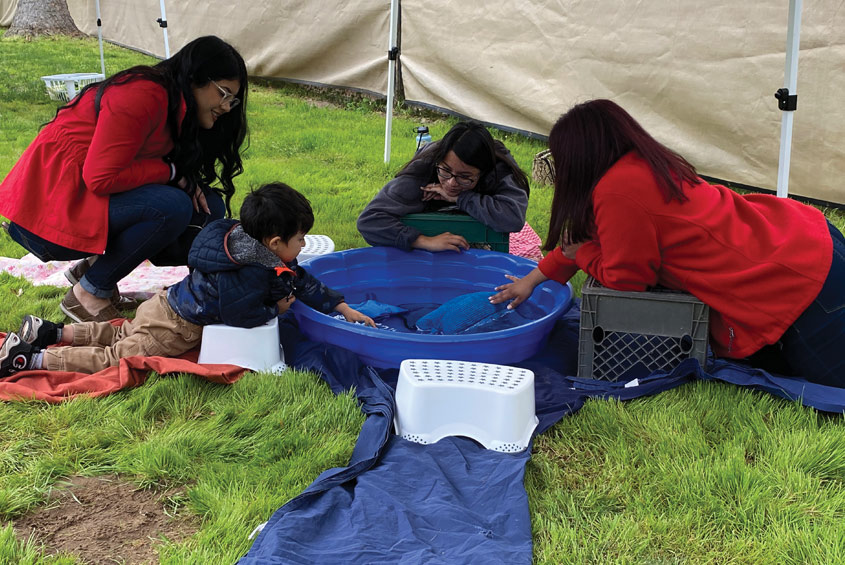
Before visiting Stingray Bay, where children can touch stingrays in the water, this station allows the Fresno Chaffee Zoo guests to learn the rules and simulate the experience to ensure everyone’s safety and enjoyment.
All the work done by Jackson’s grad students was volunteer based.
“This is their community in Fresno, so they want to be a part of it,” Jackson says. “This gives them interest in elevating community projects beyond just doing your job and going home.”
Hands-on Science
Fresno State professor Eric Person helped design two chemistry courses that incorporate hands-on water research at the Fresno Chaffee Zoo into the curriculum.
One of them, an intro chemistry course, includes about 500 students and 20 sections per semester, and is designed to introduce Fresno State’s diverse student body to STEM (science, technology, engineering and math) courses by drawing an emotional response and connection to the zoo — a place more than 95% of students in the class are familiar with.
The other is a senior-level service-learning course in which students visit the zoo four times per semester to conduct important water filtration research. Students learn how to collect water samples, label them and then take them to an offsite lab — the Agriculture and Priority Pollutants Laboratory in Clovis — for analysis. Some tests must be performed within 48 hours of collection.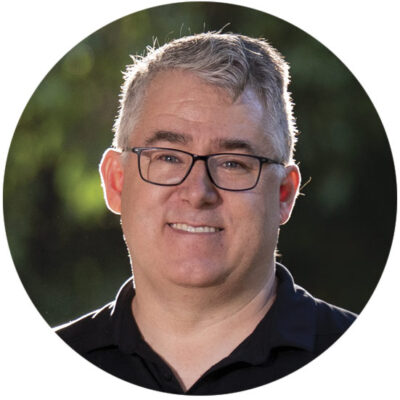
“The students are working in a commercial lab, doing professional-level testing,” Person says. “Every semester, we have students get hired straight out of that class.”
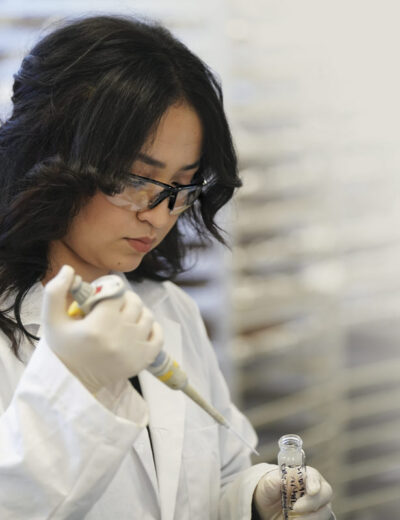 In early October, Person’s class was on standby waiting to hear when water was added to the new Kingdoms of Asia exhibition so they could test it before animals are introduced this winter.
In early October, Person’s class was on standby waiting to hear when water was added to the new Kingdoms of Asia exhibition so they could test it before animals are introduced this winter.
In addition to testing for “simple things” like salinity and pH stability, Person says he has a list of over 100 compounds students will be testing for at Kingdoms of Asia. “We’ll test for leeching of metals like calcium, magnesium, sodium and for corrosion issues,” Person says, “then they start building up a biological filter and testing for ammonia, nitrogen and nitrates.”
One of the students working on the project this semester is Claudia Ramirez, who is in her second semester of the master’s program after graduating with her bachelor’s degree in fall 2021.
Ramirez, a first-generation graduate from Central West High in Fresno, aspires to eventually earn her doctoral degree in neuroscience and go into neuroscience research. She was interested in the class to gain experience in a real-world lab setting. She’s getting that insight at the zoo.
“We went through a different entrance. I saw buildings I had never seen before,” Ramirez says. “I didn’t know we had filtration systems that close to the enclosures that were hidden from us. There’s a whole ’nother world behind the zoo that you don’t think of.”
Person says there is no other class curriculum like this in the 23-campus California State University system.
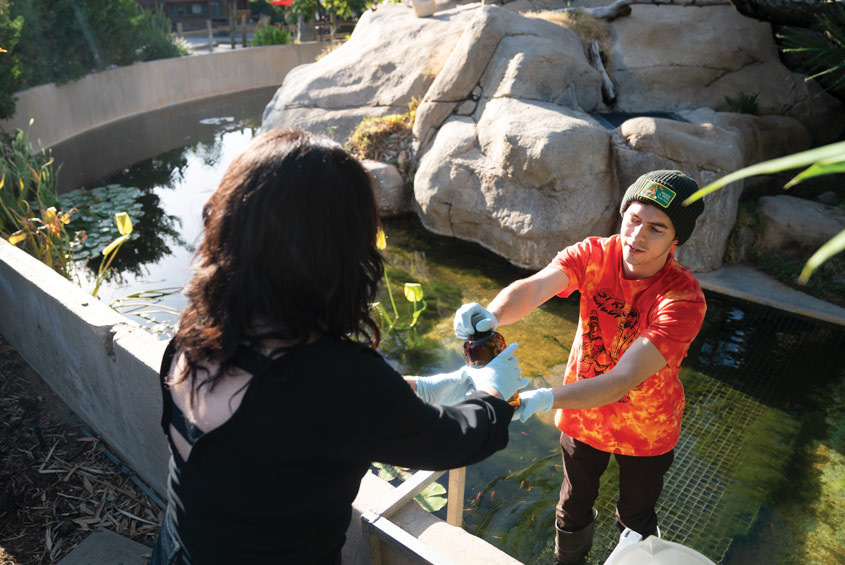
Students Claudia Ramirez and Christopher Gulbronsen are part of a service-learning course led by Dr. Eric Person in which students test and analyze water samples from the Fresno Chaffee Zoo to help ensure safe water filtration.
“People do testing of rivers. I don’t know of anyone that has a collaboration with the zoo,” Person says. “It’s really a special thing about our zoo and their interest in outreach and collaboration. It’s not just my class, there’s a lot going on.”
— Eddie Hughes (’05) is senior editor for Fresno State Magazine.
Photo credits: Cary Edmondson. All rights reserved.

